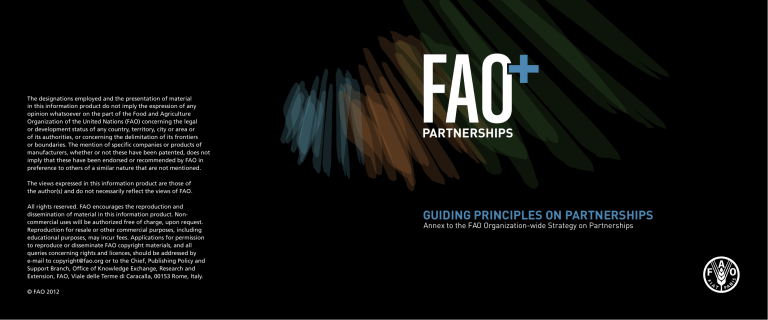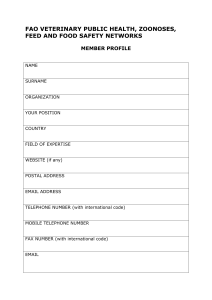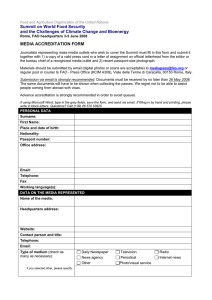
The designations employed and the presentation of material in this information product do not imply the expression of any opinion whatsoever on the part of the Food and Agriculture Organization of the United Nations (FAO) concerning the legal or development status of any country, territory, city or area or of its authorities, or concerning the delimitation of its frontiers or boundaries. The mention of specific companies or products of manufacturers, whether or not these have been patented, does not imply that these have been endorsed or recommended by FAO in preference to others of a similar nature that are not mentioned. PARTNERSHIPS The views expressed in this information product are those of the author(s) and do not necessarily reflect the views of FAO. All rights reserved. FAO encourages the reproduction and dissemination of material in this information product. Noncommercial uses will be authorized free of charge, upon request. Reproduction for resale or other commercial purposes, including educational purposes, may incur fees. Applications for permission to reproduce or disseminate FAO copyright materials, and all queries concerning rights and licences, should be addressed by e-mail to copyright@fao.org or to the Chief, Publishing Policy and Support Branch, Office of Knowledge Exchange, Research and Extension, FAO, Viale delle Terme di Caracalla, 00153 Rome, Italy. © FAO 2012 GUIDING PRINCIPLES ON PARTNERSHIPS Annex to the FAO Organization-wide Strategy on Partnerships GUIDING PRINCIPLES ON PARTNERSHIPS Joining forces for a hunger free world. With a view to contributing to achieving the objectives of the organization-wide strategy on partnerships the following guiding principles should be applied whenever the Organization is reviewing existing partnerships or is considering entering into a new partnership or alliance. The set of guiding principles should be understood as a “living document”1 which will remain subject to future revisions in the light of the experience made. The additional annotations and more detailed comments and remarks on the individual guiding principles are designed to facilitate their systematic application in the selection, prioritization, development, review and management of FAO partnerships. 1. IPA, C 2008/4, paragraph 49 GUIDING PRINCIPLE 1 A partnership should lead to a clear and mutual added value in terms of results relevant to shared goals and objectives, weighted against costs and impediments. This is the fundamental Guiding Principle. Any decision regarding the development, support, selection, prioritization, revision, renewal or termination of a partnership should be based on a careful assessment of the value-added or benefits that it generates for both FAO and its partners, expressed in terms of expected results relevant to shared objectives. It might be tempting to look at benefits exclusively from the point of view of FAO as an Organization, but an effective, sustainable partnership requires that benefits accrue not only to FAO but also to its partners, be those benefits of a similar or different nature. The assessment of benefits should involve both a qualitative and quantitative dimension. It should also attempt to establish a direct link between partnership results and the strategic goals and objectives of FAO, and how the partnership contributes to the Millennium Development Goals (MDGs) and other internationally agreed development goals. Positive elements of partnerships need to be weighed against direct and indirect savings on the one hand, and costs and impediments to the effectiveness of partnerships on the other. Thus, while the complementary work of partners may allow FAO to reallocate its resources to other areas of work, the transaction costs of partnerships need to be estimated at the outset so that adequate financial resources can be made available. Partnership costs should also be seen as an investment; they should be weighed against the expected benefits and as well as against any negative aspects if a particular partnership under consideration were not to materialize. GUIDING PRINCIPLE 2 A partnership should serve as a means for greater effectiveness in supporting international governance of agriculture and agricultural development, including through resultsbased monitoring and incorporating lessons learned, in line with FAO’s goals and strategic objectives. FAO does not always need to partner to pursue its goals. It is, however, desirable for FAO to partner when an alliance promises value added in the pursuit of shared goals. Partnering is also vital for FAO to link with other organizations committed to improving the international governance of food and agriculture. Some partnerships will be targeted to very specific areas of work. Others will be broader, covering a range of normative and operational activities and with the direct involvement of end users. attained, so as to assess their value in the context of wider corporate goals. This is the first step for a rational decision as to whether to undertake, continue or terminate a particular partnership. Partnership objectives also need to be checked for alignment with FAO’s Strategic Framework and how they contribute to the attainment of its goals and objectives. Partners should agree on how to monitor performance to ensure results orientation, mutual learning and applying lessons learned. A corollary of this principle is that partnerships need to specify the objectives or purposes or ends to be Another corollary of this principle is that, once FAO recognizes the value of pursuing shared goals in a partnership with other entities, it needs to regard the commonality of those goals not only as a key factor in determining the success of the partnership but also as an important means for achieving the strategic goals and objectives of FAO. As strongly underlined by the IEE, generic partnership arrangements need to be avoided. Partnerships should always serve a mutually agreed purpose.2 2. FAO: The Challenge of Renewal, Report of the Independent External Evaluation of FAO, C 2007/7A.1-Rev.1, Box 5.2 ( after paragraph 876) ©FAO/Danfung Dennis / FAO GUIDING PRINCIPLE 3 Building on ongoing collaboration, new partnerships should be based on the comparative advantages of each partner. Partnerships are not generated in a vacuum but are, in most cases, the outcome of long standing collaboration between FAO and other entities. However, not all forms of collaboration should be translated into partnerships. There are cases of loose collaboration that are not supported by any formal agreement to pursue shared objectives. There are examples of collaboration that change their nature in an unplanned way, driven by circumstances, which would be difficult to define as real partnerships. Only once a collaborative relationship has been tested through time and common goals agreed, can it evolve into a more targeted partnership. The ways in which FAO enters into a partnership may also differ. In some cases, the terms of the partnership are decided directly, through negotiations between FAO and the collaborating partner(s). In other cases, the terms of the partnership pre‑exist, stemming from inter-governmental decisions or extensions of established networks or coordination mechanisms. In all cases, the decision to engage in a partnership or to convert a collaborative link into a more targeted alliance requires a careful assessment of the mutual comparative advantages from which both FAO and its partners can benefit, along with the mutual value-added for achievement of shared goals. GUIDING PRINCIPLE 4 The nature of the role of FAO in a partnership which could be that of a leader, facilitator or participant, should be determined by the nature and relevance of inputs and services to be provided. The scale of importance of FAO’s contribution to a partnership varies according to the nature and relevance of its inputs. These inputs are determined by FAO’s comparative advantages. Just as these comparative advantages vary, so do the roles played by the FAO in a broad selection of partnerships. In some partnerships, FAO’s technical contribution will be of a key nature and will thus have a leadership role. In others, FAO may have a subsidiary role as facilitator (or convener or focal point), drawing on its experience as a natural repository of specific competencies or functions. In yet other partnerships, FAO will have a complementary role to play as a contributor to efforts where other partners have the key responsibilities (e.g., in humanitarian assistance emergencies, where FAO interacts with agencies primarily devoted to emergency relief). In all cases, when operating concrete partnerships, it is important to consider FAO’s contributions and those of its partners, if not of equal weight, to be at least fully part of the joint effort. GUIDING PRINCIPLE 5 FAO must at all times preserve its neutral and impartial role in partnerships and act in a transparent manner while at the same time avoiding any conflict of interest The impartiality and neutrality of FAO is a key condition for retaining its trustworthiness as a development partner, in particular in circumstances of political difference or when conflicts of interest arise. FAO is expected to provide the best possible unbiased guidance for the governance of agriculture and to bring this impartiality also to its partnerships, whether offering technical advice or procurement services. In this regard it should be recalled that as a member of the UN development system, FAO shares the fundamental characteristics of the operational activities for development of the UN system as constantly upheld by member governments, i.e. “their universal, voluntary and grant nature, their neutrality and their multilateralism, as well as their ability to respond to the development needs of programme countries in a flexible manner, and that the operational activities are carried out for the benefit of programme countries, at the request of those countries and in accordance with their own policies and priorities for development”. When it participates in partnership arrangements, FAO must ensure that its technical advice is immune from undue influence of others, and is inspired by the highest quality of technical knowledge. FAO’s participation in partnerships must also be in line with internationally agreed development goals, including the MDGs, support national development plans, and be consistent with the Strategic Framework of the Organization. FAO can find its respect for these requirements put to the test when it collaborates with partners that do not share an approach of neutrality and impartiality, but have special comparative advantages in terms of technical know-how. Neutrality does not mean indifference with regard to social and economic challenges. FAO’s technical advice needs to be informed by the highest interests of the international community. Neutrality is therefore combined with a social commitment towards the pursuit of the highest development goals in a rights-based approach. 3. General Assembly Resolution A 62/208 on the 2007 TCPR, paragraph 3 ©FAO/Vasily Maximov / FAO GUIDING PRINCIPLE 6 The implementation of global partnerships should take into account conditions and requirements at regional and country levels In order to have a significant bearing at the regional, sub-regional and country levels, global partnerships need to take into account conditions for their implementation at those levels. The decentralized organizational structure of FAO – its regional and sub‑regional offices, regional multi-disciplinary teams and country representations – plays a key role in implementing FAO’s global partnerships. At the regional and sub-regional level, FAO structures interface with regional and sub-regional inter-governmental institutions. Global partnerships often have significant manifestations also at the country level. FAO is actively involved in developing and implementing partnerships conceived directly at the national level. FAO country offices enter into partnerships for a variety of purposes including joint implementation of projects in the framework of technical assistance to governments, joint programming, advocacy initiatives to raise awareness, joint studies or knowledge-oriented partnerships, and so on. Notwithstanding limitations at the country level, there appears to be considerable potential for expansion of partnerships at this level.


